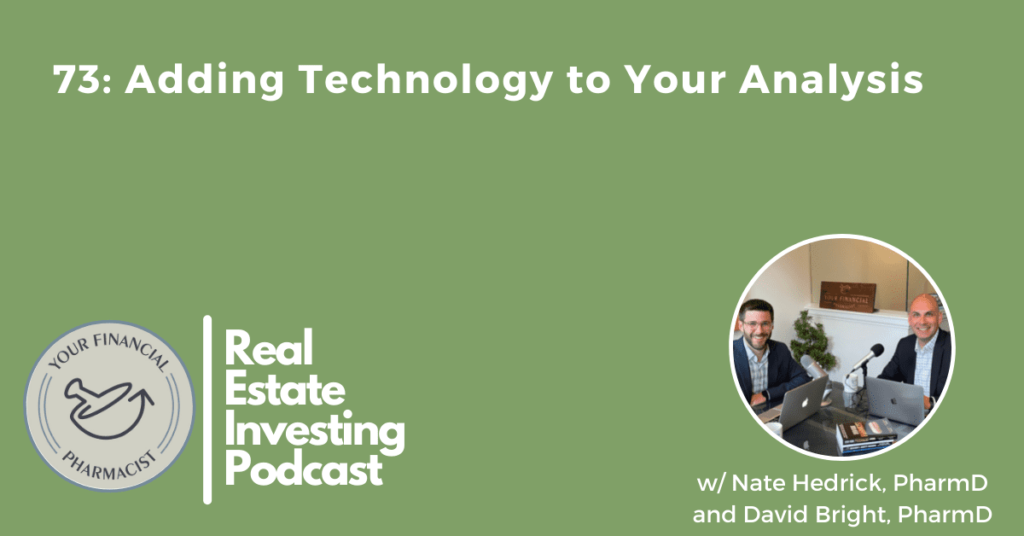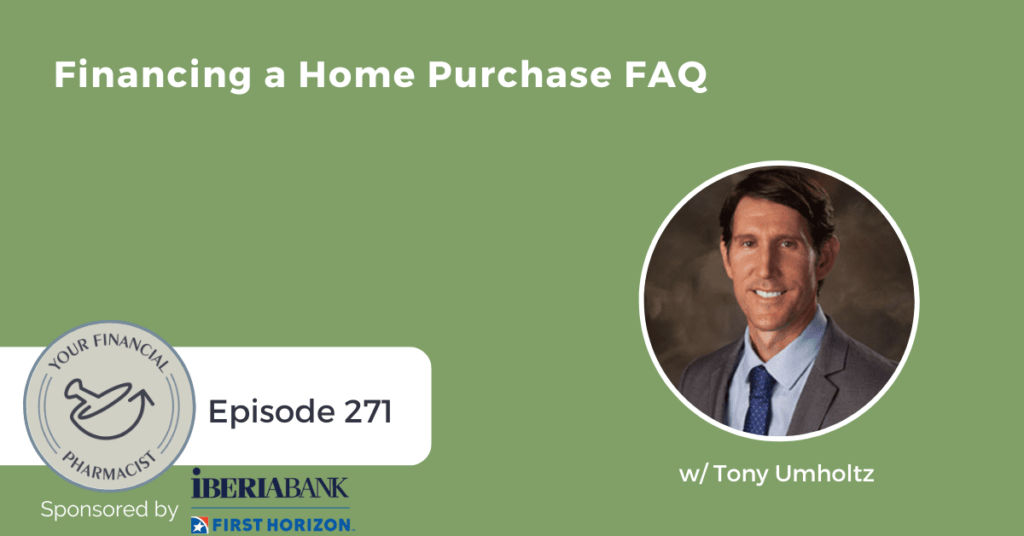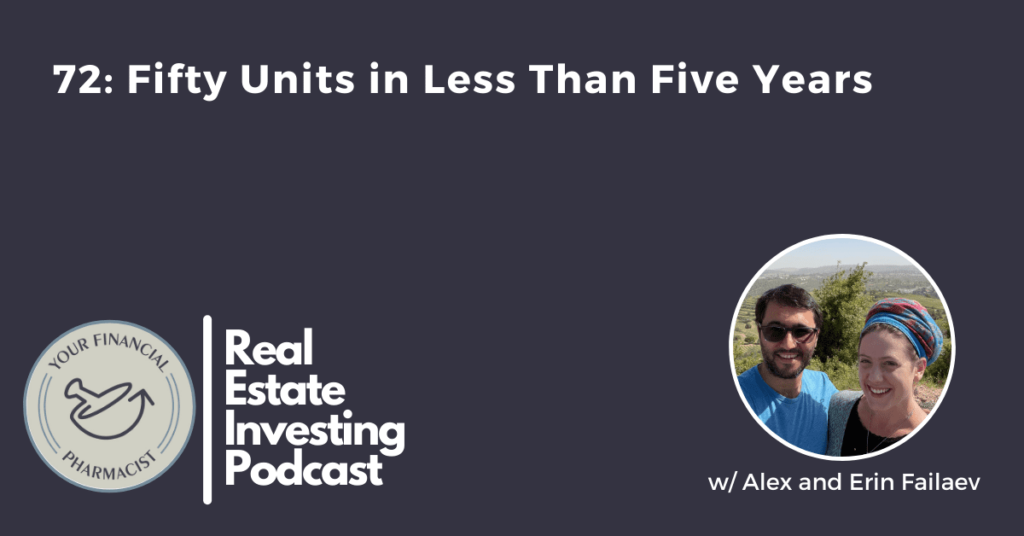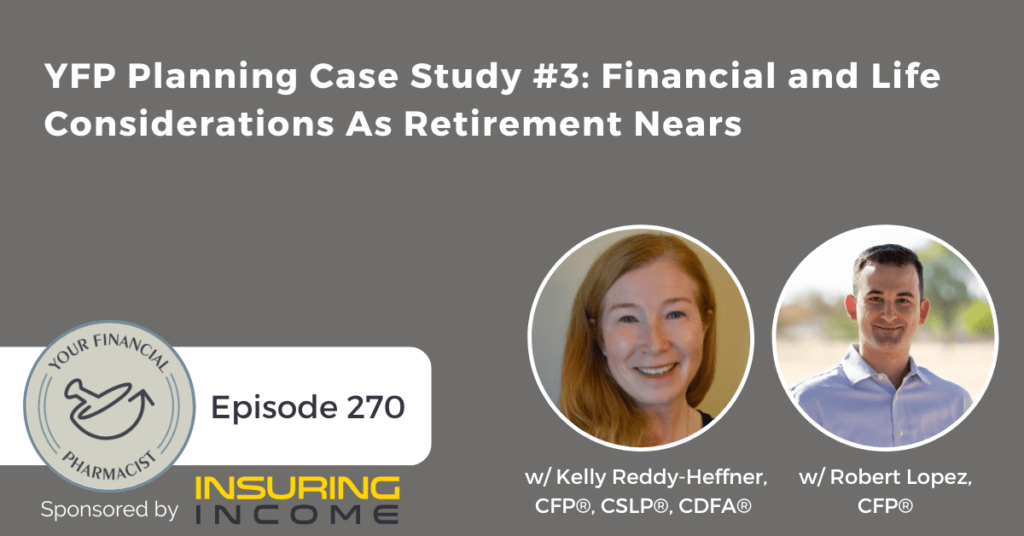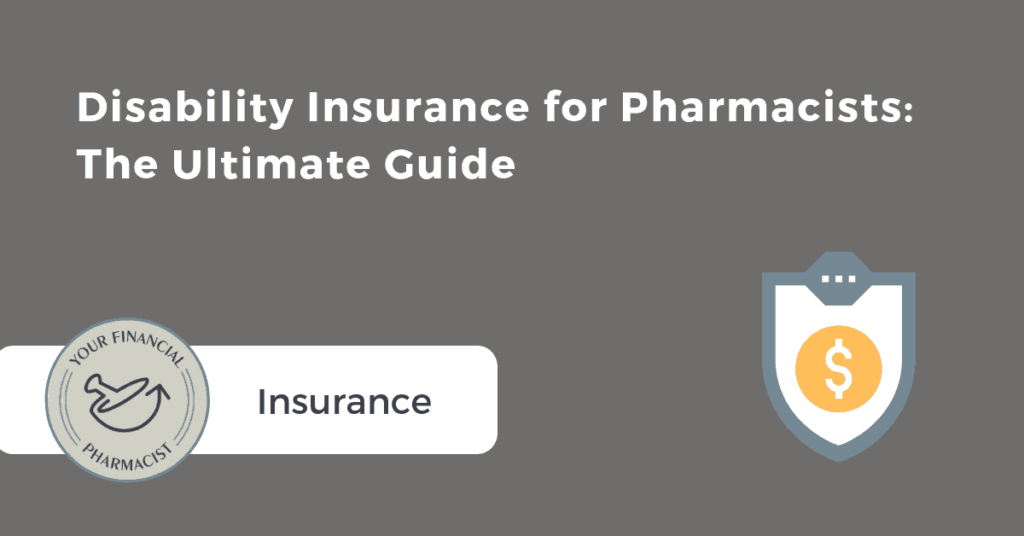
The following post contains affiliate links through which YFP or its team members may receive compensation.
I had received another email at work one morning indicating that “Julie” was not going to be in and that coverage would be needed. I knew this wasn’t planned otherwise her clinic would have been closed in advance. I didn’t know her that well so I had no idea the reason she was out but wondered what was going on and if something bad had happened.
A few weeks later it was revealed at a meeting that Julie would not be coming back to work and the reason why. You see, Julie had been struggling with rheumatoid arthritis for a long time and for many years was able to manage her disease and work full-time without any issues. Unfortunately, and unbeknownst to most of her co-workers, her disease had been progressing over the past couple of years causing tremendous pain and stiffness that became so bad that she had to drop to part-time and eventually stop working altogether.
Since she was relatively young and likely expected to work several more years, I had often wondered if she was going to be ok financially. How was she going to be able to support herself and her family without an income?
One of the greatest financial assets you have as a pharmacist is your ability to generate an income. Think about how long it took you to get to that point of becoming licensed. Six years? Eight years? Maybe more with residency or fellowship? Think about the energy, the focus, the sacrifices you made. What if that income was suddenly taken away?
Remember, you are going to have projected lifetime earnings in the millions.
Disability insurance is really income insurance. It provides you with money in the event that you are unable to work because of an accident or illness.
In the example below, let’s say a 25-year-old pharmacist wants a policy for approximately 60% of his or her income (~126,000) . A monthly (or annual) premium is paid and if a disability occurs at age 35, that pharmacist would receive $6,250 per month until age 65 when the coverage ends. We will discuss some of these specifics a little later on.
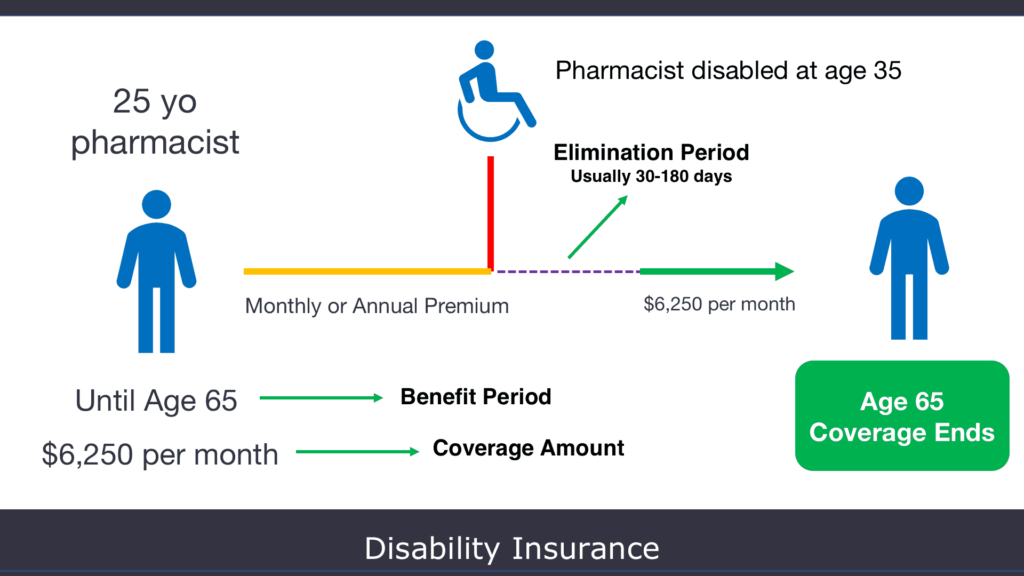
I know what you may be thinking, “As a pharmacist, something pretty bad would have to happen to me to not be able to work.” That may be true. After all, most pharmacists just require their cognitive faculties to be intact, and therefore accommodations could be made in the event of broken bones or limited mobility secondary to an accident. Right? Remember, you are not invincible!
The Social Security Administration predicts that more than 25% of today’s 20-year-old Americans will become disabled before the age of 67. However, almost 70% of those working in the private sector do not have disability insurance. Beyond car accidents, think about potential insidious diseases like Parkinson’s disease, dementia, cancer, or MS. There a lot of health-related scenarios that could occur at a young age and either force you out of the workplace or reduce the time you are able to work.
Besides being able to afford typical bills such as food, mortgage, utilities, etc, think about your student loans. If you still have federal loans then you don’t have to worry because these are discharged in the event that you become permanently disabled. However, what about private loans? Or ones that you refinanced?
Depending on the company, you may still be on the hook for making payments. We have partnered with a number of refinance companies and some such as Earnest will discharge the loan balance similar to the Department of Education.
Therefore, unless you already have substantial wealth or have additional income streams and don’t require an income as a pharmacist to live, you need disability insurance.
Disability insurance is typically classified as short-term or long-term based on the length of the policy. Although not always the case, short-term disability policies are typically up to 5 years and tend to provide you with a monthly benefit very quickly from the time a claim is made. Many times these are offered by your employer or through a pharmacy association.
If you have many working years ahead, then you really should consider a long-term disability insurance policy. Most of these policies can be in force up until age 65-70, which can ensure you will have income until you are eligible to claim social security or other retirement benefits. The time to which benefits are paid once a claim is made is known as the elimination period which will typically be longer (30-180 days) for a long-term disability policy.
This often brings up the question of whether one needs both a short-term and long-term policy. If you have a good emergency fund and sick leave that can cover the elimination period for a long-term disability policy, then this may negate the need for any short-term policy. Now if your employer offers you short-term at no or very low cost then definitely don’t pass on the benefit.
For the rest of the post, we are going to focus on breaking down the components of long-term disability insurance for pharmacists.
I will be honest with you. Disability insurance is not cheap, especially when compared to term life insurance. Before we get into some typical premiums you can expect to pay, let’s break down all of the things that can impact what you will actually pay. And just brace yourself, because there are a lot! The first time I received some quotes, my head was spinning because of all the features and factors they display.
Coverage Amount
This is one of the biggest determinants of how much you will pay for your long-term policy. How much you need depends on your current income, your savings, and how much you need to maintain a desired lifestyle in the event you can no longer work. A general rule is to consider 60% of your gross income as this should be pretty close to your take-home pay after taxes. If you pay your premiums out of pocket, and not through your employer, your benefits will be tax-free. Typically most companies will have a max of somewhere of 60-70% of gross income.
If you are a government employee, you probably won’t be able to get a policy for 60% of your gross income. The reason is that there are benefits available to you in the event you are disabled. You will have to check your agency and see what you are entitled to. If you are a FERS (Federal Employee Retirement System) employee, which includes all VA pharmacists, check www.opm.com for more information. This is the reason you are asked on your initial application or quote whether you are a government employee.
Benefit Period
How long do you want to receive benefits in the event you become disabled? This will be a key question to answer and what you choose will have a large impact on what you pay. Assuming you have many working years left and have no substantial savings and will depend on earning an income, then you should probably consider choosing a benefit period up until around age 65. But depending on your situation, you may not need something in place until then and could consider a shorter period.
The way most quotes with long-term policies is that they will show you the cost of 5 years, 10 years, and then age 65, 67, or 70 or something similar to that as you can see in the example below.
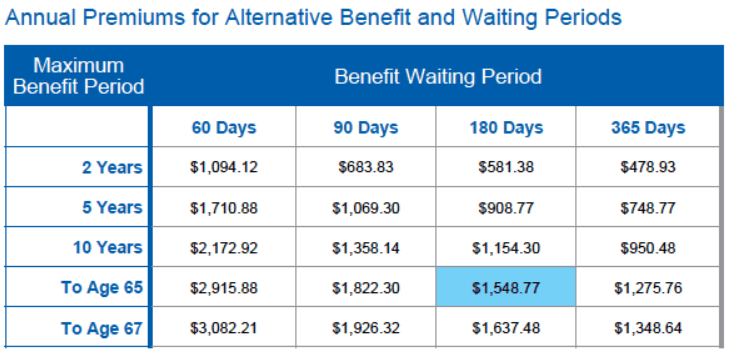
Elimination Period
As mentioned above, the elimination period or waiting period is the time between when a claim is filed and when you actually start receiving benefits. This is typically 30-365 days. As you can see in the example above, the longer the elimination period, the cheaper your premiums will be. If you have an adequate emergency fund and have built up some paid time off, you may be able to opt for a longer period.
Payment Frequency
Like car and life insurance, you can often shave some money off your premium if you pay annually or biannually. It may not be significant savings, but every little bit helps. You can see the example below of how payment frequency can make an impact.

Age / Health History
Similar to life insurance, your premium will be determined in part by your age and how healthy you are. Your weight, smoking status, past medical history, history of DUI, and any past suspensions of your professional license will also be considered.
Occupation
Most insurance companies have 5-6 occupation classes that are stratified based on the risk of injury with day-to-day activities. Pharmacists and other white-collar professionals are generally in the highest class which has a lower cost of coverage compared to other classes.
Riders
Have you ever tried to purchase a car and notice they always try to upsell you with all the bells and whistles? Long-term disability insurance policies are filled with them! That’s what makes them so complicated. It’s not like term life insurance where you just put in your info and then choose an amount and time frame for the policy to be active. Instead, these policies are jam-packed with extra benefits and features. Some, depending on the policy, are baked in and include all of these benefits while others don’t have them included. This is something to pay close attention to when you are evaluating policies and getting quotes. In addition, because the definitions are not universal, some companies may define riders slightly differently than others.
Let’s break down some of the common ones you will probably see:
Own Occupation
What if you suffered from a disability that affected your critical thinking skills and prevented you from working as a pharmacist, but you could still work in another profession likely at a lower pay? Unless you have a true own occupation rider, you may not get the full benefit or possibly no benefit at all.
This is one of the major distinctions between many workplace offerings and what you can get on your own. Some policies offer own occupation coverage but only for a couple of years. After that point, if you can perform other work, your benefits may cease. This is probably the most important feature you want in a policy and want it to be in force for the whole term of the policy.
Non-cancelable
This rider prevents your insurance company from canceling the policy (unless you aren’t paying your premiums). With a non-cancelable plan, you have the right to renew the policy every year without any increases in the premium or reduction in benefits.
Guaranteed Renewable
Having this in place means that the insurer is obligated to continue providing coverage unchanged as long as the premiums are paid. However, unlike the non-cancelable rider, premiums could go up over time.
Future Purchase Option
You can buy more coverage in the future if your income goes up with this rider. Remember, disability insurance is paid out as a percentage of your income, so you would want this to be increased as your income goes up, unless your expenses stay the same and inflation is non-existent. This rider is also known as benefit increase and may be particularly important when your income is lower initially such as during residency.
Cost of Living
Often referred to as COLA (cost of living adjustment), this rider helps protect your benefits to be protected against inflation over time. The key thing to remember here is that the adjustment for any cost of living does not begin until the disability occurs.
Partial Disability or Residual Benefit
If you become disabled, you may not be able to work full-time or your usual hours, but maybe you can still work part-time. Many policies have this rider in place so that if you experience any reduction in pay because of a disability, you can get a percentage of your benefits.
Waiver of Premium
In the event you become disabled and you start to receive benefits, who would want to continue paying for the policy during that time? That is exactly what this rider does. It eliminates the need to continue paying premiums during the period you are receiving benefits.
Student Loan Rider
This allows you to purchase additional coverage to pay student loan balances while on the claim. Remember, this won’t be necessary if you have federal loans as they will be discharged in the event of permanent disability. Where this could be a consideration is if you are with a student loan lender that does not offer this protection.
Is your head spinning yet after all this jargon? Believe it or not, there are even more options and features that exist that I didn’t even get into! Again, because some companies bake some of these riders into policies and others require you to pay an additional amount in premiums, you have to look at everything when trying to compare multiple quotes.
Remember how I said disability insurance wasn’t cheap? As you can tell by the estimated monthly premiums in the chart below, I wasn’t lying. If you are a female who graduates as a pharmacist at a traditional age of 25 and is relatively healthy, you can expect to pay about $2,112 per year assuming you want a benefit of 60% of your gross income with the additional features mentioned.
You can see that premiums for women are much higher than they are for men. Sorry ladies! This is because companies set their rates based on their claims experience and they have found that they are more likely to pay for claims for their women policyholders.

So what can you do to cut down these costs? As mentioned there are a lot of features you can add or leave off and obviously, the fewer add ons the less you will potentially have to pay. Another thing to consider is maybe you don’t need a benefit of 60% of your income. Your lifestyle may not require that much and perhaps you could live just fine off 40%.
Remember, you can also extend the elimination period and make annual payments to also help cope with the costs. Also, if your employer offers some benefits, you might consider this as well when determining your needs.
The other thing to consider is that if you are not in the best shape and are overweight or have uncontrolled hypertension, becoming healthier prior to submitting your application could also be to your benefit.
I know this can seem like very expensive insurance to have in place and you may not feel like you can afford it. But can you really afford to not have it? Are you willing to take the gamble? Remember, if anything happens to you, how are you going to pay your bills and potentially support those who depend on your income?
As I mentioned a few times, it is possible you have some form of this benefit through your job. Besides the coverage amount, benefit duration, and whether they offer true own occupation coverage, one of the biggest things to consider is the portability of the policy. If you were to leave to take another job, would the policy go with you? Remember, if you are in excellent health and leave your job after 5 years, your new employer may not offer it and you could be paying a lot more in premiums simply because of your age.
That’s the major advantage of an individual long-term disability insurance policy. It doesn’t matter where you work or if you change jobs because it follows you and you don’t have to get another evaluation of your health status.
There are many reputable companies out there that offer quality coverage with the features I talked about. However, it can take a lot of time and energy to get multiple quotes and your phone could be ringing off the hook with offers and reps trying to get your info. That’s why Your Financial Pharmacist has partnered with Policygenius, an online independent broker that helps you get a long-term disability insurance quote from multiple companies for the coverage that’s right for you.
They have a very user-friendly interface and their team helps you through the entire process. You can even get an estimate without entering any of your personal information.
Check out the video below where I walk you through their interface and how quickly you can get an estimate.
Unless you already have substantial wealth or are very close to retirement, long-term disability insurance should be an important part of your financial plan. Although it can be pretty expensive, remember all of the time and effort it took to get to where you are today. In addition, if you are married, have a significant other, or have children, you have to consider how they are affected by your ability to earn an income. No one is invincible and there are so many things that can happen that you can’t predict. Using an online broker such as Policygenius allows you to get multiple quotes from reputable companies and can save you time through the entire process.
